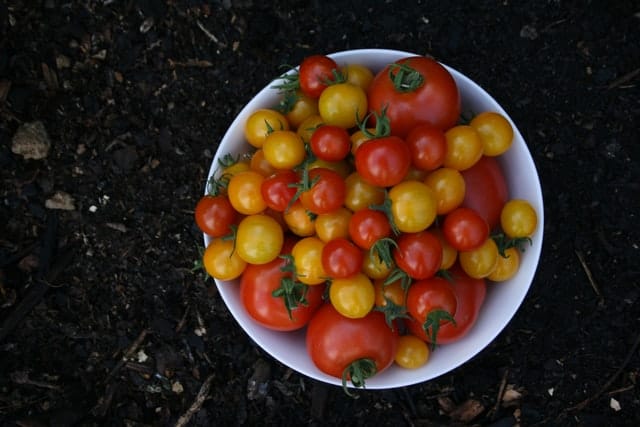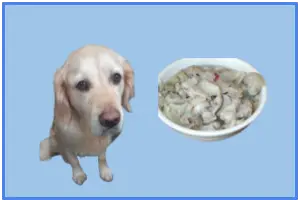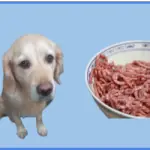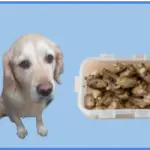
All dog parents know the guilty feeling you get when you’re cooking yourself a yummy meal and the dog sits near you expectantly. Well, if it’s a salad you’re making you can safely offer your dog a nice juicy cherry tomato!
By themselves, cherry tomatoes are not dangerous for dogs, but, of course, you need to give them to your pet in moderation and supervise him while he’s devouring his unexpected treat.
Let’s have a look at the health benefits of feeding tomatoes to your dog and the possible risks you need to be aware of.
What are the health benefits of feeding cherry tomatoes to your dog?
Cherry tomatoes make for a nice snack for your furry friend because they’re low in calories and high in fiber, which is good for digestion. Fiber also helps regulate blood sugar values. At the same time, cherry tomatoes are rich in vitamins and minerals.
For instance, cherry tomatoes are a great source of vitamin C, which is known to boost the immune system and also helps maintain a healthy skin. They also contain significant amounts of vitamin A, which is good for the dog’s eyes.
Cherry tomatoes are a good source of potassium, a mineral that sustains muscle function.
As for nutritional value, that’s not something you should worry about. One average cherry tomato (17g) barely has 3.1 calories. By comparison, one large 120g tomato has 22 calories.
If your pet eats store-bought dog food, chances are he’s already been exposed to tomatoes. Some brands list tomato pomace as one of the ingredients. This tomato pomace is made of skin, pulp and crushed seeds and manufacturers add it to their products as it’s high in fiber and promotes good digestion.
Why might you be wary of feeding cherry tomatoes to your dog?
If you do a bit of research on the topic you’ll notice that some point to the fact that cherry tomatoes (and all tomatoes, in general) contain solanine and tomatine, which are considered toxic for dogs. And for humans.
Alpha-tomatine is a natural substance which helps the tomato plant to defend itself against pests. However, it is found mainly in the green parts of the plant, leaves, vines and stem, as well as in green tomatoes. In a ripe tomato the amount of tomatine is lower and, though toxic, your dog would have to eat a ridiculous number of cherry tomatoes to be in any real danger.
According to one study, an average 60 lbs dog would have to gulp down 472 large green tomatoes (not the small red cherry type) to ingest a dangerous quantity of tomatine. In other words, offering your dog a couple of cherry tomatoes won’t harm your dog in any way.
As for solanine, this is a toxic compound found in many plants of the nightshade family, including white potatoes, egg-plants and tomatoes. Once again, the amount of solanine in ripe tomatoes, let alone small cherry tomatoes, is so low your pet would have to make his way through a basket full of them to be in any significant danger.
Bottom line: there’s nothing to worry about if your dog eats a few cherry tomatoes, but, if you have tomatoes growing in your garden, you should prevent your pet from getting to them. As mentioned before, the green parts of the tomato plant have higher levels of dangerous compounds. Now, tomato leaves don’t look appetizing to any of us, but a bored dog might just decide to have a nibble at them, so make sure to fence in your tomato plants.
Also, when you feed cherry tomatoes to your dog make sure to remove any green stuff, just to be on the safe side.
As far as tomato seeds are concerned, they are packed with vitamin A and C, but they’re a bit hard to digest, so your pet won’t benefit much from them. They won’t harm him, either.
Are cherry tomatoes a choking hazard?
This is indeed a cause for concern if your dog tends to eat his food without bothering to chew it. Also, your pet might be so excited to get a treat he might accidentally swallow it whole and this is a choking hazard. You should always watch your pet while he eats his tomatoes, or, better yet, cut them in pieces to be totally safe.
Should you feed your dog red or yellow cherry tomatoes?
Both varieties are safe for pets and there’s no difference between them as far as the nutritional value is concerned. They have roughly the same amount of beta carotene, which the body processes into vitamin A.
However, red cherry tomatoes have three times as much vitamin C than yellow ones.
The yellow variety has more niacin and folate, while the red one is rich in vitamin B6 and pantothenic acid (vitamin B5).
Red cherry tomatoes do have something over yellow ones, that is lycopene, an antioxidant which helps prevent cancer among other things. It is also the substance that gives them the color red, which explains why you won’t find any of it in yellow tomatoes.
All of these substances are in trace amounts, obviously, so it doesn’t really matter which type you feed your dog. You can alternate between the two just to make him think he’s getting something different and be happy how lucky he is.
Should you feed your dog raw or cooked tomatoes?
As with other fruit and vegetables, raw is better as cooking may destroy some of the nutrients, especially vitamins.
If you want to cook there’s no problem with that, just make sure whatever you’re making doesn’t have too much salt, which is dangerous for dogs.
When you offer your dog tomatoes for the first time, make sure to start with a small amount, like a couple of slices, and watch for a reaction. Allergic reactions to tomatoes are extremely rare, but you must keep in mind that they are slightly acidic and could cause problems to a dog with a sensitive stomach.
In case cherry tomatoes do not agree with your dog, you should expect a bout of diarrhea and vomiting, which can easily be cured by putting the dog on a bland diet for a couple of days. However, most dogs tolerate tomatoes very well.
What is the best vegetable to feed your dog?
While buying the dog’s food from the pet shop is very convenient for a busy pet owner, remember that your furry companion also needs vegetables in his diet, not just for the fiber content, but also to get valuable nutrients like vitamins and minerals.
Carrots are one of the best vegetables for dogs, and highly appreciated. If served raw, the dog will love having something to chew on, but you can also offer them steamed or boiled. Good for the eyes and teeth!
Broccoli is also a good source of fiber and vitamin C, either raw or cooked, but don’t expect your dog to be barking with joy at the sight of it.
Your dog’s diet should also include green beans, peas, celery or Brussels sprouts, either raw or cooked
Sweet potatoes and corn are also recommended, but only served cooked. And do remember to remove the corn from the cob, or your dog will eat that too.
All of these make for great snacks to reward your dog with, but you can also mix them with his regular food.
You can also offer your dog fresh fruit, a few slices of apple, blueberries or seedless watermelon. Bananas are also excellent for dogs, but no more than a few slices as they have a lot of sugar.
Some experts say a dog who eats kibble doesn’t need vegetables, but that would be assuming that dog food manufacturers only put the very best of everything in their products. Would you bet your dog’s health on that?
How many vegetables should you feed your dog?
A dog’s diet should be based on protein, which means meat and the occasional bone. Fruit and vegetables make a nice addition, but the total amount offered should not exceed 10% of their daily food.
Most of the vegetables recommended for dogs are low in calories, but this does not mean zero calories. If you serve your dog veggies on top of their normal kibble, it might cause problems if your dog is already prone to obesity.
Closing Thoughts
Cherry tomatoes are very good for your pet as they are a good source of fiber, vitamins A and C, as well as minerals. Make sure to only feed your dog ripe potatoes. Green tomatoes, just like the tomato plant’s leaves and vines contain toxic substances, at least if ingested in large enough quantities.
If you want to give your dog a healthy snack, red or yellow cherry tomatoes are perfectly safe, but you might want to cut them into smaller pieces to avoid choking.






